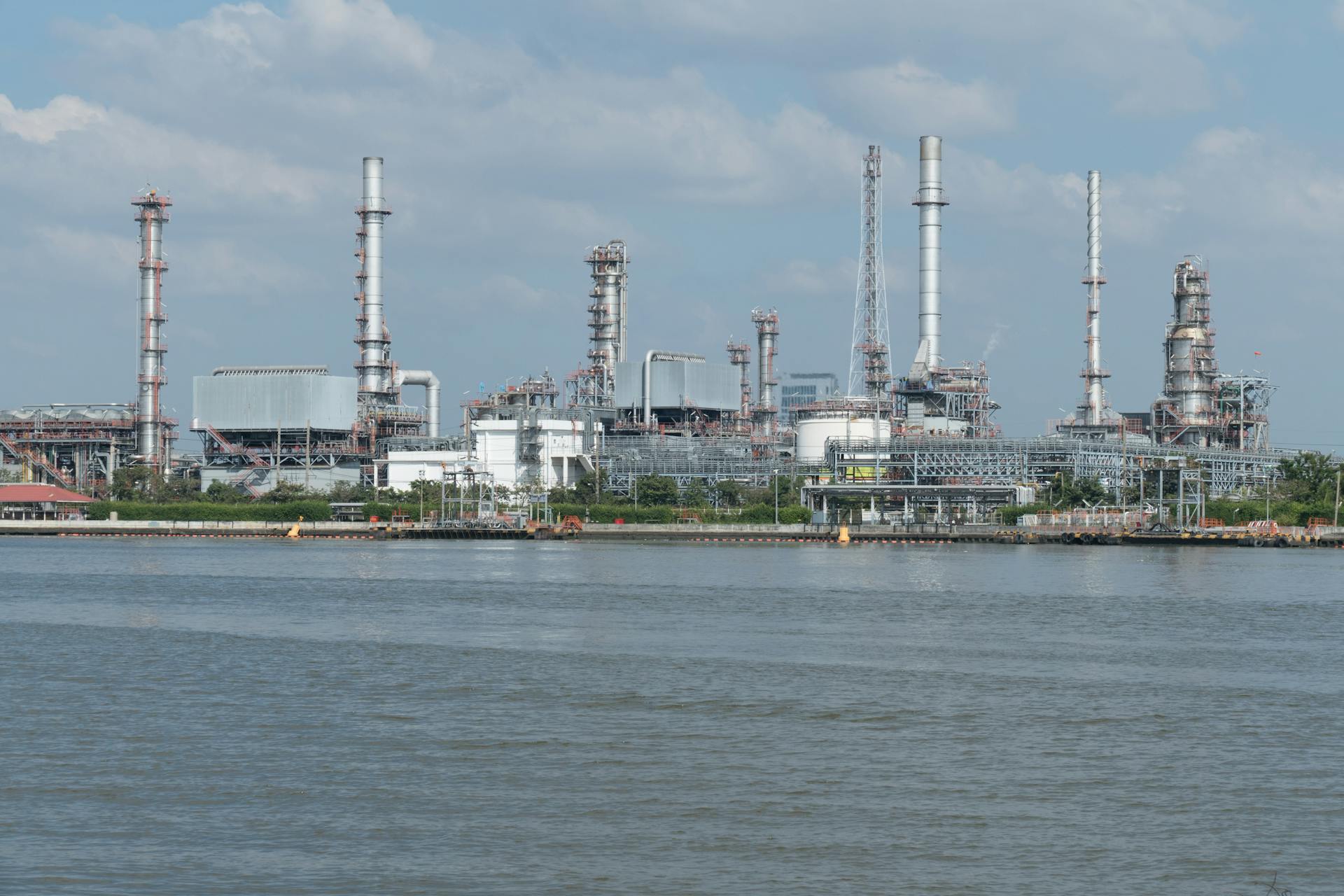
The United States has strict regulations in place to control ship pollution, including emissions and waste. The Clean Water Act of 1972 prohibits the discharge of pollutants from vessels into the nation's waters.
The Act requires ships to use approved waste management systems and adhere to strict guidelines for the disposal of hazardous waste. This includes the use of incinerators, treatment plants, and other technologies to minimize pollution.
The U.S. Environmental Protection Agency (EPA) is responsible for enforcing these regulations and ensuring compliance. The agency has set limits on the amount of pollutants that can be discharged from ships, including particulate matter, sulfur dioxide, and nitrogen oxides.
For more insights, see: England Ships
Federal Laws & Regulations
Federal laws and regulations play a crucial role in regulating ship pollution in the United States. The U.S. Coast Guard and EPA have principal regulatory and standard-setting responsibilities.
The EPA's Vessel General Permit (VGP) applies to cruise ships that are 79 feet in length or greater, and requires them to meet specific environmental standards. The VGP was published in 2013 and has undergone revisions since then.
Cruise ships that are smaller than 79 feet are subject to the ballast water requirements of the VGP, Coast Guard regulations, and applicable state and local government requirements. This is because the Small Vessel General Permit (sVGP) was repealed in 2018 under the Vessel Incidental Discharge Act (VIDA).
Here are the key federal agencies responsible for regulating ship pollution in the United States:
- U.S. Coast Guard: responsible for enforcing regulations and standards
- U.S. Environmental Protection Agency (EPA): sets environmental standards and enforces regulations
- Department of Justice: prosecutes violations of federal laws
- Department of State: represents the United States in international treaty negotiations and pursues foreign-flag violations
US EPA
The US EPA plays a significant role in regulating cruise ships in U.S. waters. The EPA has implemented MARPOL Annex VI in its national legislation, establishing NOx and sulphur emission control areas.
One key regulation is the Vessel General Permit (VGP), which requires cruise ships 79 feet or greater in length to comply with specific requirements. The most recent VGP was published in 2013, and it covers various aspects of vessel operations.
In 2014, the EPA introduced the Small Vessel General Permit (sVGP), which applied to smaller cruise ships, specifically focusing on ballast water. However, this permit was repealed in 2018 under the Vessel Incidental Discharge Act (VIDA).
Discover more: Cruise Ship Pollution in the United States
Currently, small vessels are subject to the ballast water requirements of the VGP, Coast Guard regulations, and applicable state and local government requirements. The EPA has also published proposed VIDA implementation regulations, which aim to streamline the regulatory framework for cruise ships.
Here's a summary of the key EPA regulations affecting cruise ships:
Purpose
The purpose of federal laws and regulations is to protect the environment and prevent pollution from ships. The Act to Prevent Pollution from Ships, 1980, as amended, is a key piece of legislation in this area.
This act has been implemented through various annexes and protocols, including Annexes I, II, and V of the International Convention for the Prevention of Pollution from Ships, 1973. These annexes and protocols aim to reduce pollution from ships and protect the marine environment.
The Exclusive Economic Zone (EEZ) plays a crucial role in enforcing these regulations, extending from the baseline of the territorial sea seaward 200 miles as defined in the Presidential Proclamation 5030 of March 10, 1983. This zone is essential for regulating shipping activities and preventing pollution.
The EEZ also encompasses the Antarctic region, which is protected by the Protocol on Environmental Protection to the Antarctic Treaty done at Madrid on October 4, 1991. This protocol aims to conserve the Antarctic environment and prevent pollution in this sensitive ecosystem.
Here's an interesting read: Baltimore Inner Harbor Ships
Penalties for Violation
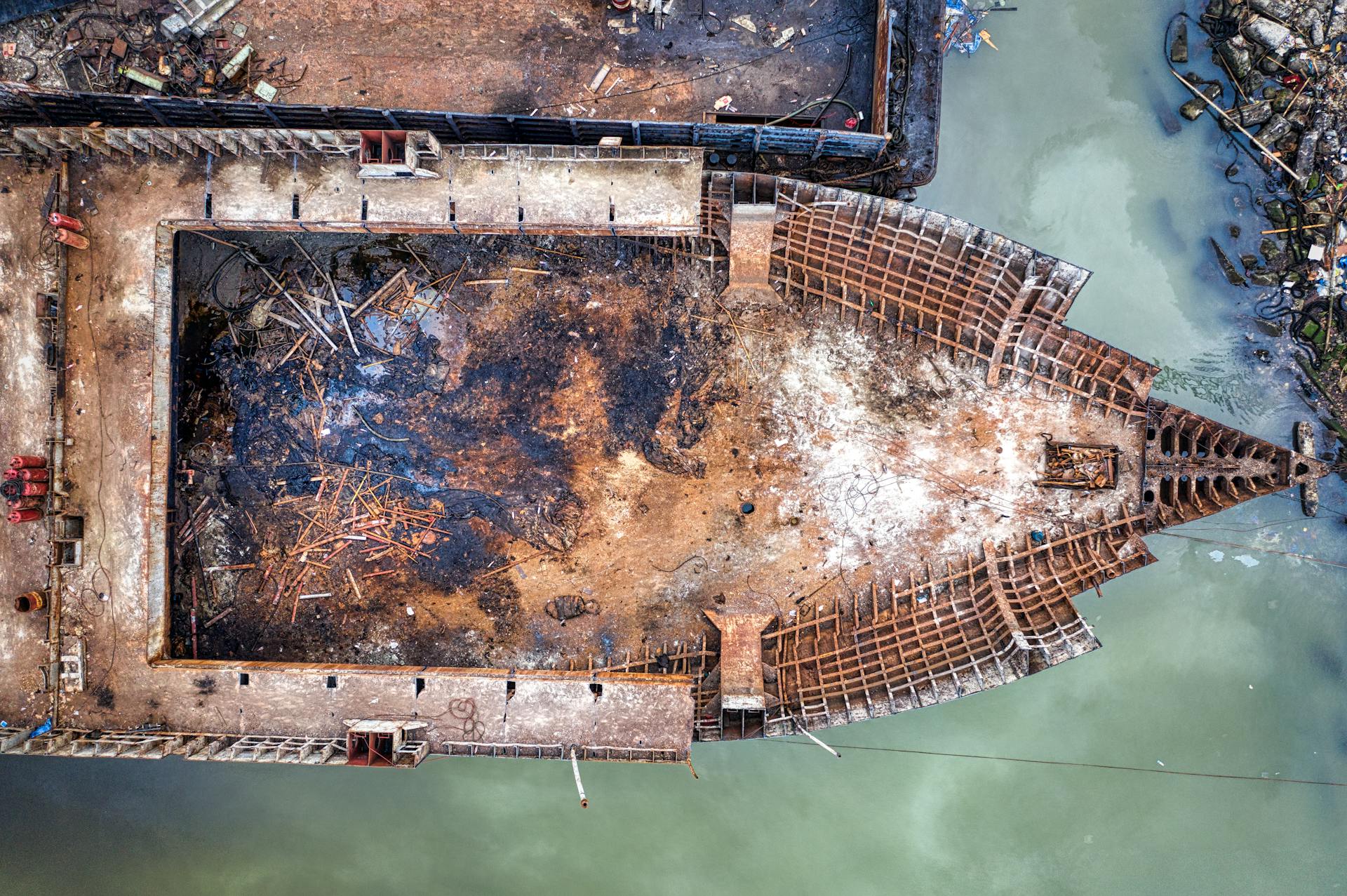
A person who violates MARPOL 73/78, the Act, or the regulations of this subpart is liable for a civil penalty for each violation, as provided by 33 U.S.C. 1908(b)(1).
Each day of a continuing violation constitutes a separate violation, making it a serious offense to continue violating the regulations.
A person who makes a false, fictitious statement or fraudulent representation in any matter in which a statement or representation is required to be made to the Coast Guard is liable for a civil penalty for each statement or representation, as provided by 33 U.S.C. 1908(b)(2).
Knowingly violating MARPOL 73/78, the Act, or the regulations of this subpart can lead to a class D felony, as described in 18 U.S.C. 3551et seq.
In the discretion of the Court, a fine can be paid to the person giving information leading to conviction, with the amount not exceeding one-half of the fine.
A ship operated in violation of MARPOL 73/78, the Act, or the regulations of this subpart is liable in rem for any civil penalty or fine, and can be proceeded against in the United States District Court of any district in which the ship may be found.
Here's an interesting read: International Convention on Civil Liability for Oil Pollution Damage
Ship Pollution
Ship pollution is a significant concern in the United States, with cruise ships being a major contributor to the problem. Cruise ships generate a number of waste streams, including sewage, graywater, hazardous wastes, oily bilge water, ballast water, and solid waste.
These waste streams can result in discharges to the marine environment, posing a threat to human health and aquatic life. In fact, the waste streams generated by cruise ships are not unique to them, but the large numbers of passengers and crew they carry make their impact more significant.
Cruise ships tend to concentrate their activities in specific coastal areas, which can lead to a cumulative impact on a local scale. For example, Florida, California, New York City, Galveston, Seattle, and the waters of Alaska are frequently visited by cruise ships, making their impact more pronounced in these areas.
The good news is that some cruise lines have taken steps to reduce their pollution. For instance, Princess Cruises and Royal Caribbean Cruise Line have adopted reusable items to reduce waste, and recycling programs have been implemented on some ships. This has resulted in the United States alone gaining upward of 18,000 pounds of recycled goods from these practices.
Explore further: Ballast Water Regulation in the United States
Some cruise lines are also exploring cleaner energy sources, such as liquefied natural gas (LNG), which is a much cleaner source of energy than oil. In fact, Carnival Corporation has partnered with Shell to use LNG to power its next two new ships, which will help reduce their bilge pollution.
The regulations surrounding ship pollution in the United States are also worth noting. For example, the Clean Water Act prohibits the discharge of oil or hazardous substances in harmful quantities into U.S. navigable waters. Additionally, the Act to Prevent Pollution from Ships (APPS) implements MARPOL Annex I concerning oil pollution, and the Coast Guard has promulgated regulations prohibiting the discharge of oil or oily mixtures into the sea within 12 nautical miles of the nearest land.
Here's a summary of the regulations surrounding ship pollution in the United States:
- Oil tankers of 150 gross tons and above and other ships of 400 gross tons and above must carry a shipboard oil pollution emergency plan approved by their flag state.
- Foreign flagged vessels must comply with regulations prohibiting the discharge of oil or oily mixtures into the sea within 12 nautical miles of the nearest land.
- The Clean Water Act prohibits the discharge of oil or hazardous substances in harmful quantities into U.S. navigable waters.
- The Act to Prevent Pollution from Ships (APPS) implements MARPOL Annex I concerning oil pollution.
Cruise Ship Pollution
Cruise ships generate a number of waste streams that can result in discharges to the marine environment, including sewage, graywater, hazardous wastes, oily bilge water, ballast water, and solid waste.
These wastes can be a significant source of pathogens, nutrients, and toxic substances with the potential to threaten human health and damage aquatic life.
Cruise ships carry large numbers of passengers and crew, and produce large volumes of waste as a result.
They tend to concentrate their activities in specific coastal areas, and visit the same ports repeatedly, which can have a significant cumulative impact on a local scale.
Some cruise lines have implemented new environmental strategies to reduce pollution, such as transferring from single-use plastic packaging to reusable plastic containers and cutlery.
Recycling programs have also been implemented, with the United States alone gaining upward of 18,000 pounds of recycled goods from these practices.
Carnival Corporation is one example of a cruise liner that is pursuing cleaner energies, having agreed to partner with Shell to utilize liquefied natural gas (LNG) to power its next two new ships.
LNG is a much cleaner source of energy than oil and also much less expensive, which will help cruise liners combat their problems with bilge pollution.
Oil Pollution
Oil Pollution is a significant concern in the United States, with regulations in place to prevent and mitigate its impact. The Coast Guard regulates oil pollution through the Code of Federal Regulations (CFR).
The Coast Guard first addressed oil pollution in 1989 with the publication of CGD 88-002, which was later amended in 1990. This regulation sets standards for oil pollution prevention and response.
Oil Pollution
The regulations surrounding oil pollution are complex, but they're crucial for protecting our oceans.
The U.S. Coast Guard regulates oil pollution through the Code of Federal Regulations, specifically in 46 CFR 153.903, which outlines the rules for operating a U.S. ship in a special area.
Oil pollution can have devastating effects on marine ecosystems, which is why the Coast Guard has implemented strict guidelines for ship operations.
The Coast Guard first addressed oil pollution in the Code of Federal Regulations in 1989, with the publication of CGD 88-002, which was later amended in 1990 by CGD 88-002A.
Readers also liked: Title 39 of the United States Code
The Coast Guard continues to update and refine its regulations, as seen in the 2008 amendment USCG-2008-0179, which added new provisions for oil pollution prevention.
In 2013, the Coast Guard further clarified its regulations with the publication of USCG-2012-1049, which reinforced the importance of adhering to the rules for operating a U.S. ship in a special area.
By following these regulations, ship operators can help prevent oil pollution and protect our oceans for future generations.
Control of Oil Discharges
The control of oil discharges is a crucial aspect of preventing oil pollution.
In the United States, the Coast Guard regulates oil discharges through various regulations.
The discharge of oil or oily mixture is only allowed in certain situations, such as when it's necessary for securing the safety of a ship or saving life at sea.
The owner or master of a ship must have taken all reasonable precautions to prevent or minimize the discharge after the occurrence of damage or discovery of the discharge.
Curious to learn more? Check out: Ballast Water Discharge and the Environment
The owner or master must not have acted with intent to cause damage or recklessly with knowledge that damage would probably result.
The Coast Guard has specific regulations for the discharge of oil from fixed or floating platforms.
No person may discharge oil from a fixed or floating platform engaged in the exploration, exploitation, or associated offshore processing of seabed mineral resources, unless it's an emergency.
Consider reading: United States Floating Battery Demologos
Garbage Management
Garbage management is a critical aspect of ship pollution regulation in the United States. The master or person in charge of a ship must ensure that a garbage management plan is on board and followed by each person handling garbage.
The plan must be in writing and provide for the discharge of garbage by means that meet Annex V of MARPOL, the Act, and sections 151.51 through 151.77. It must also describe procedures for minimizing, collecting, processing, storing, and discharging garbage.
Ships operating outside of special areas can discharge garbage into the sea, but only under specific conditions. For example, food wastes can be discharged 12 nautical miles from the nearest land, while cargo residues can be discharged 12 nautical miles from the nearest land or the nearest ice shelf.
Ships operating in special areas, such as the Great Lakes, have different discharge requirements. For example, food wastes can only be discharged while the ship is en route and at least 12 nautical miles from the nearest land or the nearest ice shelf.
The master or person in charge of a ship must also maintain a written record of each garbage discharge or disposal operation, including the date and time of the discharge, the location, and the categories and amount of garbage discharged.
Sewage
Sewage from commercial vessels is regulated by the Clean Water Act, which prohibits the dumping of untreated or inadequately treated sewage within 3 miles of shore.
Commercial vessels are required to obtain NPDES permits and have marine sanitation devices to prevent the discharge of untreated sewage.
Beyond 3 miles, raw sewage can be discharged, but some cruise ships use Advanced Wastewater Treatment (AWT) systems that are very effective in removing pathogens and other pollutants from sewage.
AWTs are particularly useful in areas like Alaskan waters, where the treatment of sewage is crucial to protect the environment.
States can establish no-discharge zones (NDZs) for vessel sewage, completely prohibiting the discharge of treated and untreated sewage in certain waters.
As of 2017, 72 areas representing part or all of the waters of 26 states have been designated as no-discharge zones, including a number of inland states.
Greywater
Greywater is a type of wastewater that's regulated by environmental laws.
The 2013 VGP regulates greywater discharges from large cruise ships, ensuring they meet specific standards.
Greywater must be treated before it's discharged into certain waters, like those in Alaska, where it's mandated by state law.
This treatment process helps prevent pollution and protect local ecosystems.
Garbage Management Plans
A garbage management plan is required on every ship to ensure proper handling and disposal of waste. This plan must be in writing and approved by the master or person in charge of the ship.
A fresh viewpoint: Ship Oil Pollution Emergency Plan
The plan must provide for the discharge of garbage by means that meet Annex V of MARPOL, the Act, and sections 151.51 through 151.77. This includes procedures for minimizing, collecting, processing, storing, and discharging garbage.
Each ship must have a designated person in charge of carrying out the garbage management plan. This person is responsible for ensuring that the plan is followed by all crew members handling garbage.
The garbage management plan must be on the ship at all times and must be made available for inspection by the Coast Guard. This is to ensure that the ship is in compliance with all regulations regarding garbage disposal.
The plan must be updated regularly to reflect any changes in garbage management procedures or regulations. This is important to ensure that the ship is always in compliance with the law.
Governmental Rules
The US Environmental Protection Agency (EPA) is proposing to tax carbon pollution from transportation, with unknown impact on shipping.
The US Clean Shipping Act requires all vessels above 400 GT to be fully zero emission by 2040 in US waters, making it one of the most stringent maritime laws in the world.
Mandatory shore power is required in US waters starting in 2030, as per the Clean Shipping Act.
The Ocean-Going Vessels at Berth (OGVB) regulation in California mandates shore power usage for specific vessel types starting in 2023.
One of the most stringent ports in the world, California requires all vessels to use shore power by 2027, as per the authority of CARB.
Additional reading: United Shipping & Trading Company
Delegations
Coast Guard officials designated as Captain of the Port or Officer in Charge, Marine Inspection have the authority to issue International Oil Pollution Prevention (IOPP) Certificates.
These officials can also detain or deny entry to ships that are not in substantial compliance with MARPOL 73/78 or do not have an IOPP Certificate or evidence of compliance on board.
A ship cannot enter a port or terminal unless the port or terminal has a Certificate of Adequacy, as defined in § 158.120 of this chapter.
A Captain of the Port may deny entry to a ship if the port or terminal does not have a Certificate of Adequacy, as required in § 158.135 of this chapter.
The port or terminal must also be in compliance with the requirements of subpart D of part 158 to allow a ship's entry.
Discover more: Harwich Port England
Surveys
Surveys are a crucial part of the governmental rule-making process, and they're often used to gather public input and feedback on proposed regulations. This is evident in the case of the 2019 survey conducted by the Environmental Protection Agency (EPA), which collected over 100,000 public comments on the agency's proposed rule to repeal the Clean Power Plan.
The EPA's survey revealed that a majority of respondents were opposed to repealing the Clean Power Plan, highlighting the importance of public engagement in the rule-making process. The survey results also showed that many respondents were concerned about the potential impacts on public health and the environment.

In some cases, surveys may be used to identify areas where rules need to be updated or revised. For example, a 2018 survey of small business owners by the Small Business Administration (SBA) found that many businesses were struggling with the complexity of federal regulations, leading to calls for streamlining and simplification.
The SBA's survey results were used to inform the development of new rules and regulations that are more accessible and easier to comply with. This is a great example of how surveys can be used to drive positive change and improve the regulatory environment.
Discover more: Oversize Load Requirements by State
Governmental Rules
The US Environmental Protection Agency (EPA) is proposing to tax carbon pollution from transportation, but the impact on shipping is currently unknown.
The US Clean Shipping Act is one of the most stringent maritime laws in the world, requiring all vessels above 400 GT to be fully zero emission by 2040 in US waters.
Recommended read: Us Shipyards in the United States
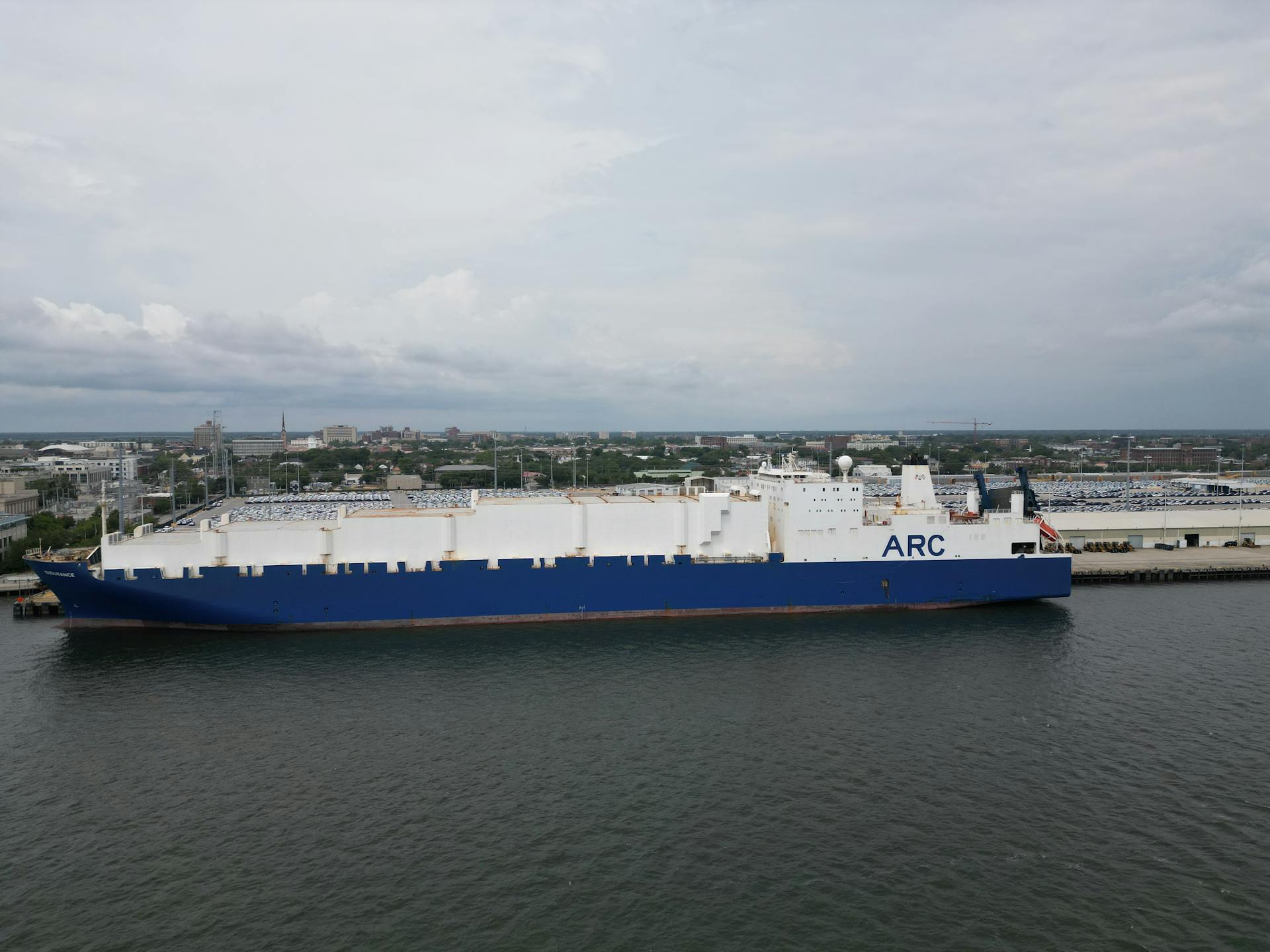
In California, the Ocean-Going Vessels at Berth (OGVB) regulation mandates shore power usage for specific vessel types starting in 2023.
By 2027, all vessels must use shore power at one of the world's most stringent ports, as mandated by the California Air Resources Board (CARB).
The US Clean Shipping Act also requires shore power to be mandatory for all vessels by 2030.
If this caught your attention, see: California Shipbuilding Corporation
Shipboard Control
The master, operator, or person in charge of a ship must ensure that all garbage is discharged ashore or in accordance with §§ 151.66-151.73.
To evaluate compliance, enforcement personnel may consider records of garbage discharges, the presence and operability of waste treatment equipment, and adherence to a written shipboard garbage management plan.
A shipboard garbage management plan must be on board and followed, and ongoing educational programs for shipboard personnel are also a factor in evaluating compliance.
Compliance Inspection
A ship's compliance inspection is a crucial aspect of shipboard control. The Coast Guard has the authority to inspect ships for compliance with regulations such as MARPOL 73/78.
The inspection can be initiated at a port or terminal under the jurisdiction of the United States. The Coast Guard may inspect a ship to determine if it has a valid IOPP Certificate on board and if the ship's condition and equipment match the certificate's particulars.
The inspection can also involve examining the Oil Record Book, oil content meter continuous records, and conducting a general examination of the ship. This is to ensure the ship is operating in accordance with regulations and not discharging oil or oily mixtures in violation of MARPOL 73/78.
Detention of the ship is possible if it does not comply with regulations or if the ship's condition and equipment do not match the required documentation. This can happen if the ship is found to be in violation of parts 151, 155, and 157 of the chapter, or if the ship's condition and equipment do not substantially agree with the particulars of the IOPP Certificate or other required documentation.
A ship can be detained until the Coast Guard is satisfied that the ship can proceed to sea without posing an unreasonable threat to the marine environment.
Exceptions for Emergencies and Health Risks
Exceptions for Emergencies and Health Risks are crucial in shipboard control. In emergency situations, the discharge of oil or oily mixture is allowed for the purpose of securing the safety of a ship or saving life at sea.
Accidental loss of garbage is permitted if all reasonable precautions have been taken to prevent or minimize the loss. This includes damage to a ship or its equipment, and the loss of fishing gear from a ship.
In cases where the retention of food wastes on board presents an imminent health risk to people on board, the en route requirements for discharging food wastes do not apply. Drainage and other wastes from toilets, urinals, and WC scuppers are also exempt from certain requirements in emergency situations.
Notice of any activity undertaken in case of an emergency must be reported immediately to the National Response Center. This includes discharging plastic or garbage mixed with plastic, which is strictly prohibited in certain areas.
Check this out: Post Office Board of Governors
Shipboard Control
The master, operator, or person in charge of a ship must ensure that all garbage is discharged ashore or in accordance with sections 151.66-151.73. This is a crucial responsibility to prevent pollution and maintain a clean marine environment.
Enforcement personnel will consider several factors when evaluating compliance with these regulations, including records of garbage discharges, the presence and operability of waste treatment equipment, and adherence to a written shipboard garbage management plan.
Records of garbage discharges, including receipts, are essential for demonstrating compliance with these regulations. These records must be kept on board the ship and made available for Coast Guard inspection.
A shipboard garbage management plan is also a critical component of shipboard control. This plan must describe the measures the vessel employs to minimize bulk dry cargo residue discharges and list or describe the specific procedures for handling and processing garbage.
The master, operator, or person in charge of a ship must ensure that garbage is properly deposited into a port or terminal's reception facility if it is transported from the ship by shipboard personnel.
A fresh viewpoint: Which States Charge Sales Tax on Shipping and Handling
Operating Requirements: Category D
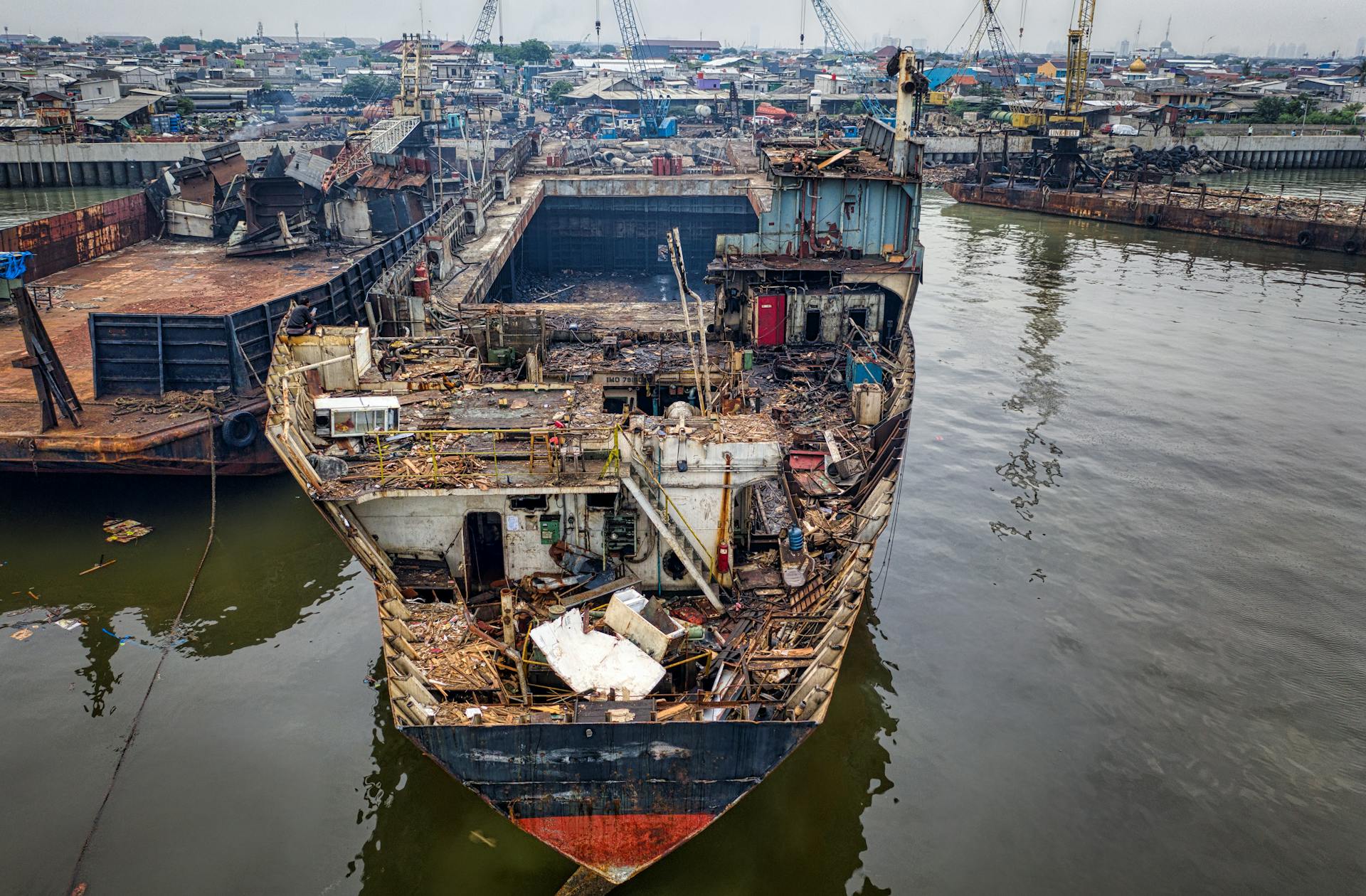
The master or person in charge of an oceangoing ship must ensure that the ship is operated as prescribed for the operation of oceangoing ships carrying Category D NLSs.
The carriage and discharge of the oil-like NLS must meet certain regulations, including those found in 46 CFR 153.901, 153.909, 153.1100, 153.1104, 153.1106, 153.1124, 153.1126, and 153.1128.
The oil-like NLS must not be discharged unless the monitor required by § 151.37(a)(1) is set to detect it, and a statement must be entered in the Oil Record Book Part II(Cargo/Ballast Operations) that the monitor has been set to detect the oil-like NLS.
Urea and Ammonium nitrate solution (2% or less NH3) are examples of substances that are not subject to the same discharge requirements as other oil-like NLS.
Operating Requirements
Operating requirements are in place to minimize the impact of ship pollution on the marine environment. These regulations apply to various types of ships, including oceangoing vessels and fixed or floating platforms.
Ships carrying Category D NLS must be operated in accordance with specific requirements, including the carriage and discharge of oil-like NLS. The master or person in charge of the ship must ensure that the ship is operated as prescribed for the operation of oceangoing ships carrying Category D NLSs in 46 CFR 153.901, 153.909, 153.1100, 153.1104, 153.1106, 153.1124, 153.1126, and 153.1128.
Discharge of plastic and garbage mixed with plastic is prohibited in the navigable waters of the United States. This includes synthetic ropes, synthetic fishing nets, and plastic garbage bags. All garbage containing plastics must be discharged ashore or incinerated.
Exceptions for Emergencies
In cases of emergencies, certain operating requirements can be waived. Discharging oil or oily mixture into the sea is allowed if it's necessary for securing the safety of a ship or saving life at sea.
The discharge of oil or oily mixture resulting from damage to a ship or its equipment is also permitted, as long as all reasonable precautions have been taken to prevent or minimize the discharge. This includes investigating the cause of the damage and taking steps to mitigate its effects.
If a ship experiences damage, the owner or master must not act with intent to cause damage or recklessly, knowing that damage would probably result. This is to prevent intentional or reckless behavior that could harm the environment.
In emergency situations, the accidental loss of garbage or fishing gear may occur, but this can be exempt from regulations if all reasonable precautions have been taken to prevent or minimize the loss. This includes investigating the cause of the loss and taking steps to mitigate its effects.
The discharge of fishing gear from a ship can also be exempt from regulations if it's done for the protection of the marine environment or for the safety of the ship or its crew. This includes situations where fishing gear needs to be removed to prevent entanglement or to clear a navigational channel.
In cases where food wastes pose an imminent health risk to people on board, they can be discharged at sea, even if it's not allowed under normal circumstances. This is to prevent the spread of disease or illness among ship passengers and crew.
Recommended read: Dali Ship Crew
Emission Control Areas
Emission Control Areas are a key factor in the adoption of LNG as ship fuel.
The introduction of more stringent air emissions limits in these areas is a major driver for this shift.
The legislative requirements are laid down in Annex VI to MARPOL, which outlines the specific regulations and guidelines.
This has significant implications for ship operators, who must comply with these new regulations to avoid fines and penalties.
Operating Requirements
Operating requirements for ships carrying Category D NLSs are governed by 46 CFR 153.901, 153.909, 153.1100, 153.1104, 153.1106, 153.1124, 153.1126, and 153.1128. The master or person in charge of the ship must ensure the ship is operated as prescribed for oceangoing ships carrying Category D NLSs.
Plastic and garbage mixed with plastic, including synthetic ropes, synthetic fishing nets, and plastic garbage bags, cannot be discharged into the sea or navigable waters of the United States. All garbage containing plastics must be discharged ashore or incinerated.
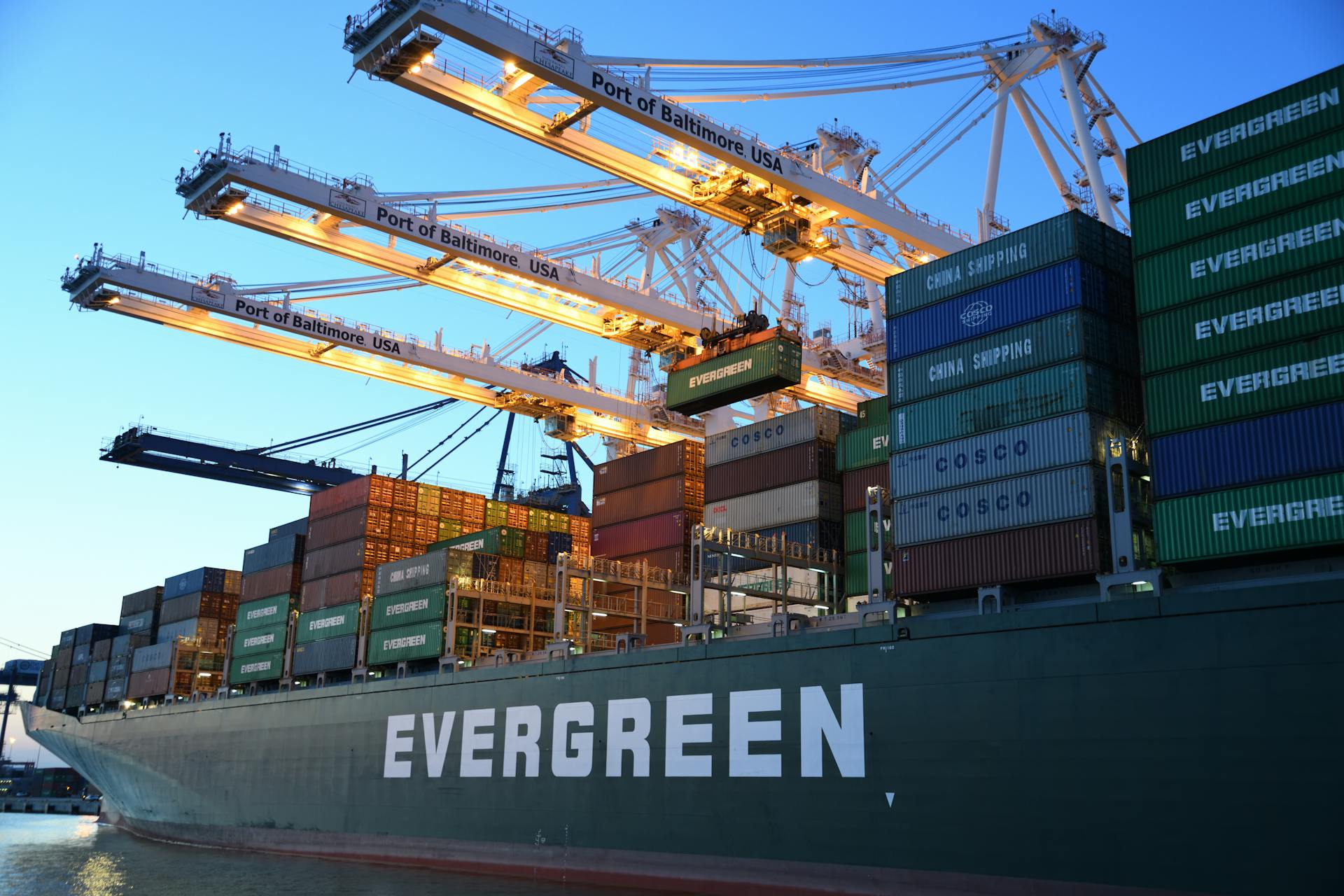
Ships operating outside of special areas must not discharge garbage into the sea, except for food wastes, cargo residues, and animal carcasses. Food wastes can be discharged 12 nautical miles from the nearest land, while cargo residues can be discharged 12 nautical miles from the nearest land if they cannot be recovered using commonly available methods for unloading.
The discharge of garbage within special areas is also regulated. Food wastes can only be discharged while the ship is en route and at least 12 nautical miles from the nearest land or ice shelf. Cargo residues can be discharged if they do not contain harmful substances and the ship will not transit outside of the special area.
The master, operator, or person in charge of a ship must ensure that all garbage is discharged ashore or in accordance with specific regulations. This includes keeping records of garbage discharges, having equipment to treat ship-generated garbage, and adhering to a written shipboard garbage management plan.
No person may discharge garbage from a fixed or floating platform engaged in offshore processing of seabed mineral resources, or from a ship within 500 meters of such platforms, except for food waste that has been processed with a grinder or comminuter.
Certificates and Placards
To operate a ship in the United States, you need to have the right certificates on board. The International Oil Pollution Prevention (IOPP) Certificate is a must-have for ships of 400 gross tons and above, or oil tankers of 150 gross tons and above, that engage in voyages to ports or offshore terminals under the jurisdiction of other parties to MARPOL 73/78.
This certificate is issued by a COTP, OCMI, or a classification society authorized under 46 CFR part 8, after a satisfactory survey in accordance with the provisions of § 151.17. The certificate is valid for a maximum period of 5 years from the date of issue, unless significant alterations have taken place in the ship's construction, equipment, or arrangements.
If you're carrying Category C oil-like NLS, you'll need a specific certificate or attachment to your IOPP Certificate. For U.S. oceangoing ships, this requires a Certificate of Inspection endorsed to allow the NLS to be carried in that cargo tank, or an Attachment for NLSs to the IOPP Certificate.
Certificates Needed for Category C Oil-Like NLS

To carry Category C oil-like NLS, a U.S. oceangoing ship needs a Certificate of Inspection endorsed to allow the NLS to be carried in that cargo tank.
A foreign oceangoing ship operating in U.S. waters must have an Attachment for NLSs to the IOPP Certificate or a Certificate of Compliance issued under 46 CFR Part 153.
A U.S. oceangoing ship authorized to carry certain dangerous cargoes in bulk under 46 CFR Part 98 needs a Certificate of Inspection endorsed to allow the NLS to be carried in that cargo tank, and an NLS Certificate issued under § 151.37(b) if it engages in a foreign voyage.
The Coast Guard allows toluene to be carried as a Category C oil-like NLS.
You'll need to check the specific regulations for the type of ship and cargo you're dealing with, but the basics are clear: get the right certificate and you're good to go.
Certificates for Category D NLS and Category D Oil-like NLS

Certificates for Category D NLS and Category D Oil-like NLS are crucial for safe and compliant operations.
A Category D NLS requires a specific set of operating requirements to be followed, as outlined in 46 CFR 153.901, 153.909, 153.1100, 153.1104, 153.1106, 153.1124, 153.1126, and 153.1128.
The master or person in charge of an oceangoing ship carrying a Category D NLS must ensure the ship is operated accordingly.
To discharge a Category D oil-like NLS, the monitor required by § 151.37(a)(1) must be set to detect the oil-like NLS.
A statement that the monitor has been set to detect the oil-like NLS must also be entered in the Oil Record Book Part II(Cargo/Ballast Operations), required by § 151.25.
Urea and Ammonium nitrate solution (2% or less NH3) are examples of Category D oil-like NLS that require specific discharge procedures.
151.59 Placards
Placards are a crucial part of a ship's compliance with regulations. They must be displayed in prominent locations, such as embarkation points, food service facilities, and common areas on deck.

Each placard must be at least 20 cm (8 in) wide by 12.5 cm (5 in) high and made of a durable material. This ensures they can withstand the elements and be easily read.
The placards must notify the reader of the operating requirements contained in sections 151.67 through 151.73, which apply to that ship. This includes the prohibition on discharging garbage into navigable waters of the United States and other waters, except as specifically allowed.
A person who violates these requirements is liable for civil and/or criminal penalties. This is a serious issue, and it's essential to take it seriously.
The placard must also notify the reader of regional, state, and local restrictions on garbage discharges. This is important for ships operating in specific areas.
For ships operating on the Great Lakes or their connecting or tributary waters, the placard must notify the reader of the prohibition on discharging garbage, except as allowed by section 151.66.
Foreign Ships
Foreign ships are subject to specific regulations when it comes to pollution in the United States.
Each oil tanker of 150 gross tons and above, and each other ship of 400 gross tons and above, operated under a foreign country's authority that is party to MARPOL 73/78, must carry a shipboard oil pollution emergency plan approved by its flag state.
These ships must comply with this requirement while in the navigable waters of the United States or at a port or terminal under the jurisdiction of the United States.
Oil tankers of 150 gross tons and above, and other ships of 400 gross tons and above, operated under a foreign country's authority that is not a party to MARPOL 73/78, must comply with a different regulation while in the navigable waters of the United States.
This regulation is outlined in § 151.21 of this subpart.
Multiple amendments have been made to these regulations over the years, with the most recent one being in 2022, as part of the USCG-2021-0348 amendment.
Frequently Asked Questions
What is the US Act to prevent pollution from ships?
The Act to Prevent Pollution from Ships (APPS) is a US law that regulates the handling and discharge of pollutants from ships. Passed in 1980, it enforces standards for ships to prevent environmental harm.
Sources
- https://www.dnv.com/maritime/hub/decarbonize-shipping/key-drivers/regulations/regional-developments/us/
- https://en.wikipedia.org/wiki/Cruise_ship_pollution_in_the_United_States
- https://www.ecfr.gov/current/title-33/chapter-I/subchapter-O/part-151/subpart-A
- https://sustainableworldports.org/clean-marine-fuels/regulations/
- https://www.sustainable-ships.org/rules-regulations/us
Featured Images: pexels.com


